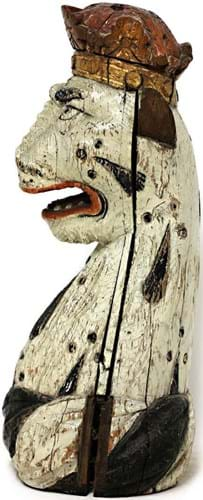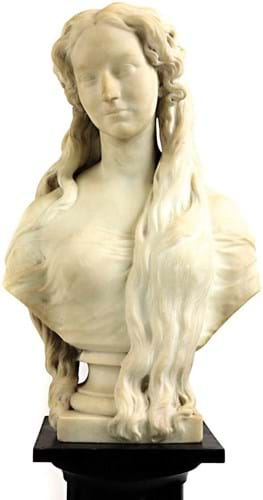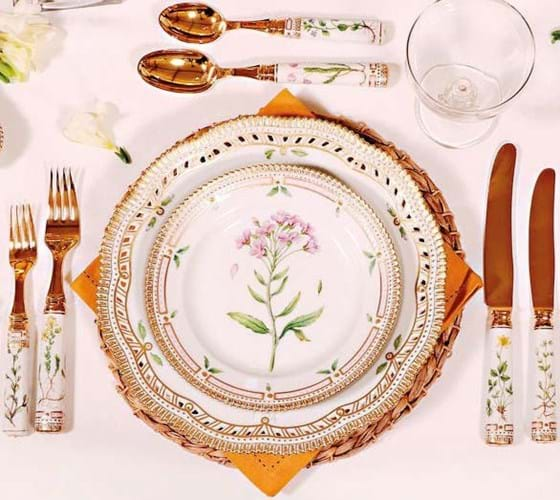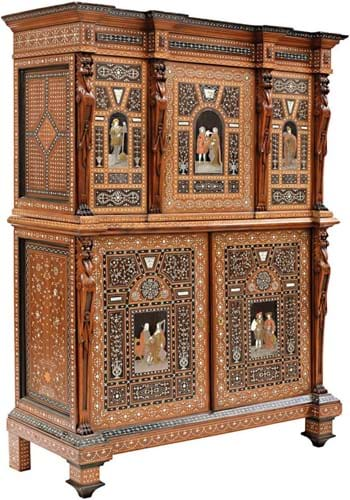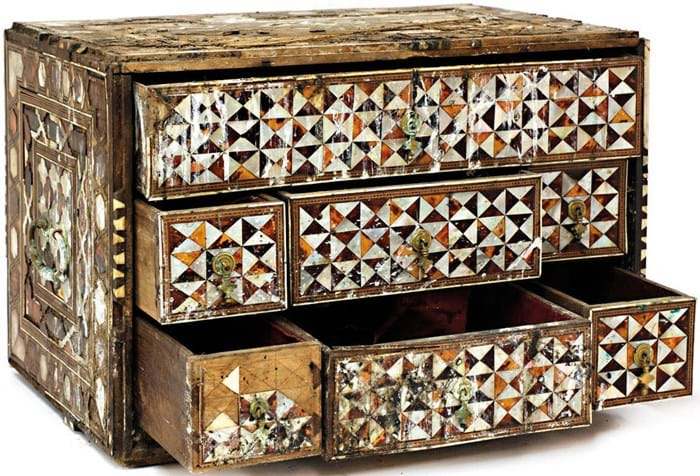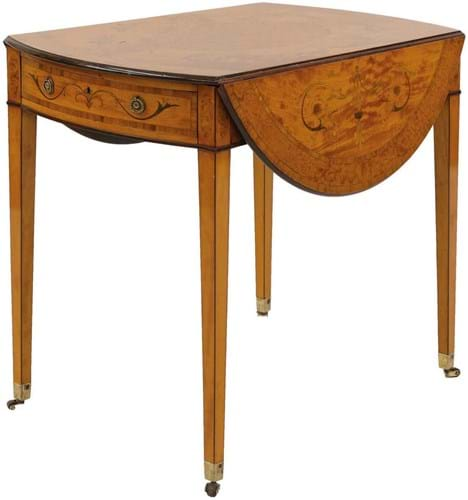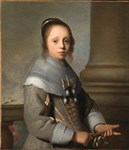Against considerable competition at Sworders’ (25% buyer’s premium) recent Fine Interiors sale, the winner of the most eye-catching lot was probably a carved and painted oak armorial head.
Dated to the first quarter of the 16th century, it raised the possibility of a connection with one of the great names of the Tudor era.
Assuming the form of a crowned leopard’s head, it bears some similarity to the Boleyn beast which adorned the palaces of Henry VIII from 1533-36, the period in which he was married to his second wife Anne. In a condition consummate with age, it came for sale in Stansted Mountfitchet on March 30-31 from a vendor who had owned it for around 40-50 years.
Estimated at £800-1200, it raised plenty of interest before selling to the UK trade at £12,000.
Jawbone becomes cane
Another example of British (or possibly American) vernacular craft to eclipse estimate was a fine marine ivory, whalebone and baleen inlaid walking stick.
Canes of this type, typically worked from the jawbone of a whale by sailors to be sold to natural history-curious Victorians in the port cities, come in many different guises. Many now appeal beyond the cane collecting community and into the folk art world.
This example was relatively sophisticated: carved to the shaft with spirals and fluting and inlaid with tortoiseshell graduated lozenges. Pitched at £600-800, it sold to a London dealer at £13,000 – a price more akin with the best canes sold in the UK regions in recent years.
Sculpture surprises
Unexpected successes among the sculpture added to the £753,000 hammer total across March 30-31.
Best was a white marble bust by Irish-born Christopher Moore (1790-1863) who made a successful living in London.
His 2ft 4in (72cm) tall bust engraved Mary-Jane, wife of George Evelyn Esquire February 1829 Christopher Moore Sculpsit, raised a lot of interest from the UK and Ireland. There were chips and cracks to the plinth but it was, said the auction house, “a very beautiful portrayal of a member of quite a significant family”.
Estimated at £1000-1500, it went to a private UK buyer at £10,500.
Smart address
A more expected reaction came for a c.1810 doll’s house. This 3ft 8in (1.12m) wide recreation of a Regency home opened to reveal four papered and furnished rooms. Carrying hopes of £7000-10,000, it sold to an American private bidder at £13,000.
The house was one of two belonging to the costume designer Evangeline Harrison who had inherited it from her friend Jocelyn Rickards, the artist and costume designer who is widely credited as having defined the ‘Swinging London’ look of the ‘60s.
Ceramics sale-topper
Top price of the sale came among the ceramics: a dinner service, coffee service and canteen of cutlery in the Flora Danica botanical pattern long the pride of the Royal Copenhagen factory.
First used on a dinner service created by royal command as a gift for Catherine the Great in 1790, it has been in production ever since.
The pieces at Essex dated from c.1960-80 and, while used with some minor signs of wear, were in good condition. All sold to an international buyer. The 74-piece dinner service took £23,000 (estimate £10,000- 15,000), the 64-piece coffee service, £13,500 (£2000-3000) and the 60-piece part-canteen of porcelain and silver-gilt cutlery marked for A Michelsen and Georg Jensen, £18,500 (£3000-5000).
The decorative – and exotic
A taste for the decorative and exotic lifted furniture prices.
A c.1900 Louis XVI-style inlaid, parquetry and mahogany marble top commode, after Jean-Henri Riesener, modelled from the Concordant Commode at the Palais de Fontainebleau, went to a European buyer against US interest at a top-estimate £6000. A set of 12 French Louis XV-style carved and polychrome painted and upholstered set of dining chairs, estimated at £400-600 took £4200.
From 19th century north Italy was a mahogany cabinet featuring geometric and flared inlays of ebony, ivory and boxwood and Renaissance figures in arched panels. The 6ft (1.83m) tall cabinet, which had some minor losses and splits, went a UK dealer within estimate at £5200.
Of similar appeal was a 6ft (1.80m) tall late 19th century Moorish hardwood cabinet on stand, profusely inlaid with ebony and ivory motifs, which doubled expectations in going to a UK private at £2800.
Also from the Middle East, an 18th century 16in (40cm) Ottoman tortoiseshell and mother-of-pearl inlaid table cabinet was extensively damaged but outpaced the £400-600 estimate, selling to a Continental collector at £2300.
By contrast, two classically restrained English Pembroke tables also went well above hopes.
Other than davenports (a decent William IV mahogany example failed to get away against a £600-800 estimate), it’s hard to think of a bigger casualty of the furniture slump than Pembroke tables.
This was reflected in the estimate on a George III Sheraton period example in inlaid satinwood. Pitched at £1000-1500, the 2ft 8in (82cm) long table had a twin oval top with a central burr thuya panel within a tied ribbon and foliate swag border and a tulipwood crossbanded edge above a frieze drawer. It sold to a private buyer at £5000.
A second George III example, but in mahogany and estimated at £400-600, went to a London dealer at £2500.
The vertiginous fall from stardom has long been seen in mahogany bureau bookcases and although attractively small, as these things go, a 6ft 5in x 3ft 1in (1.95m x 94cm) George III example was pitched at £400-600.
The cylinder fall was split in two places but was working properly, opening to reveal a fitted interior with pull-out ratcheted writing surface over three drawers and splay feet. It sold to the London trade for £4200.


